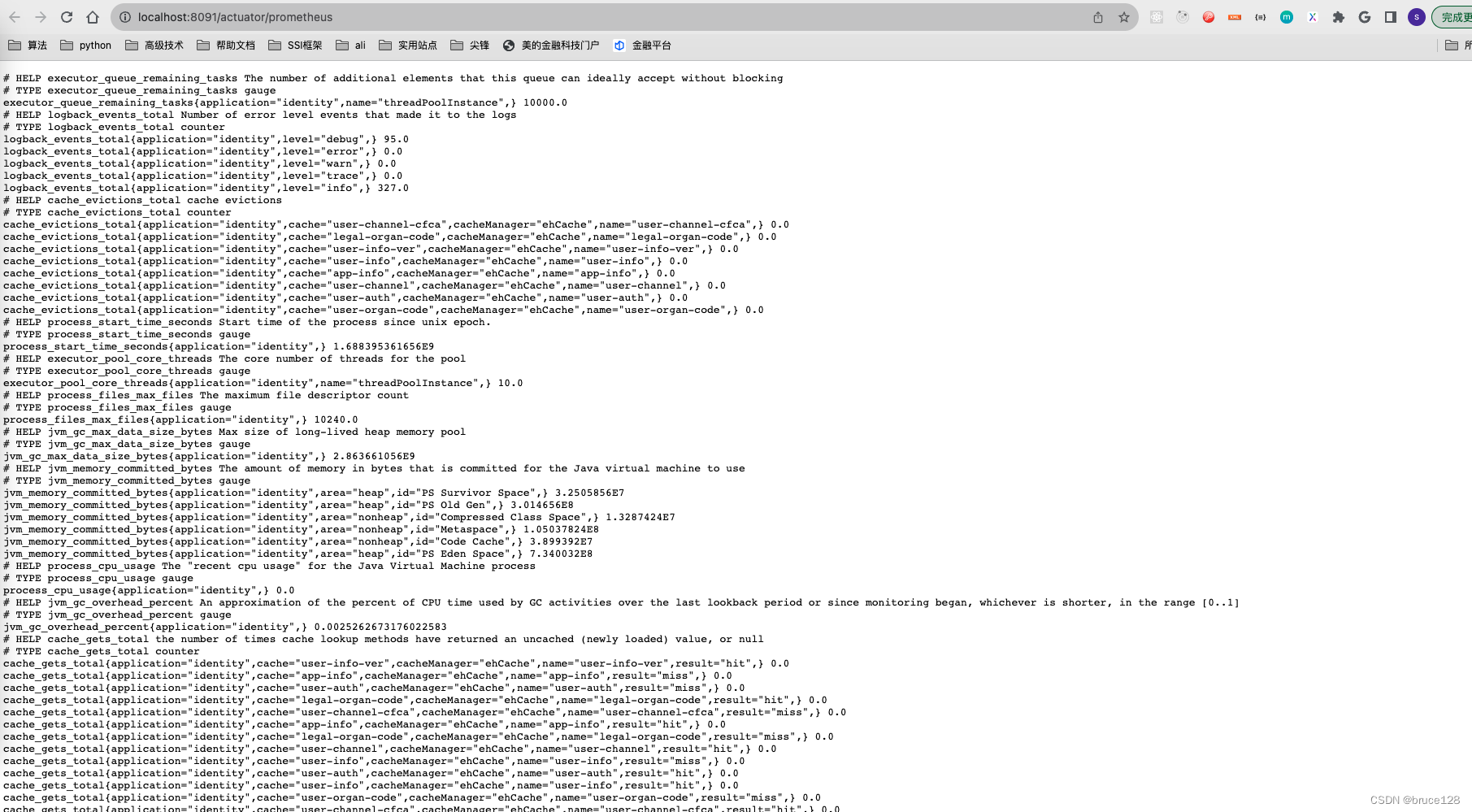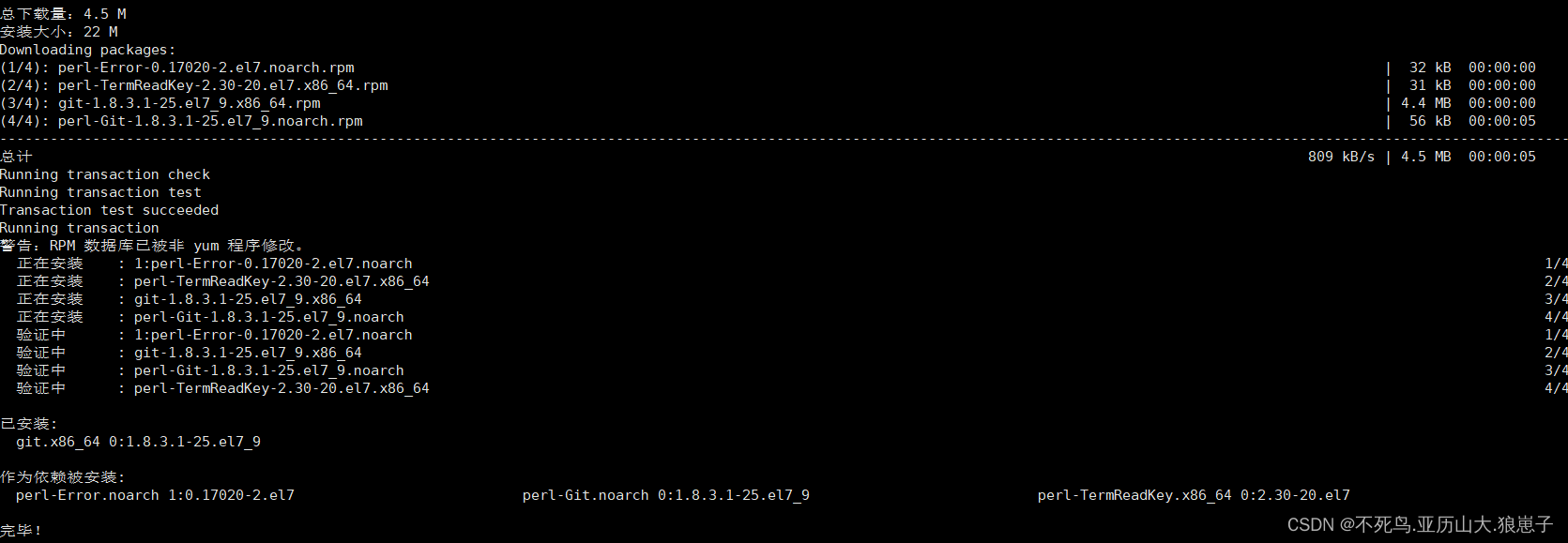1. 图的遍历
给定一个图
G
和其中任意一个顶点
v0
,从
v0
出发,沿着图中各边访问图中的所有顶点,且每个顶
点仅被遍历一次
。
"
遍历
"
即对结点进行某种操作的意思
。
请思考树以前是怎么遍历的,此处可以直接用来遍历图吗?为什么?
1.1 图的广度优先遍历



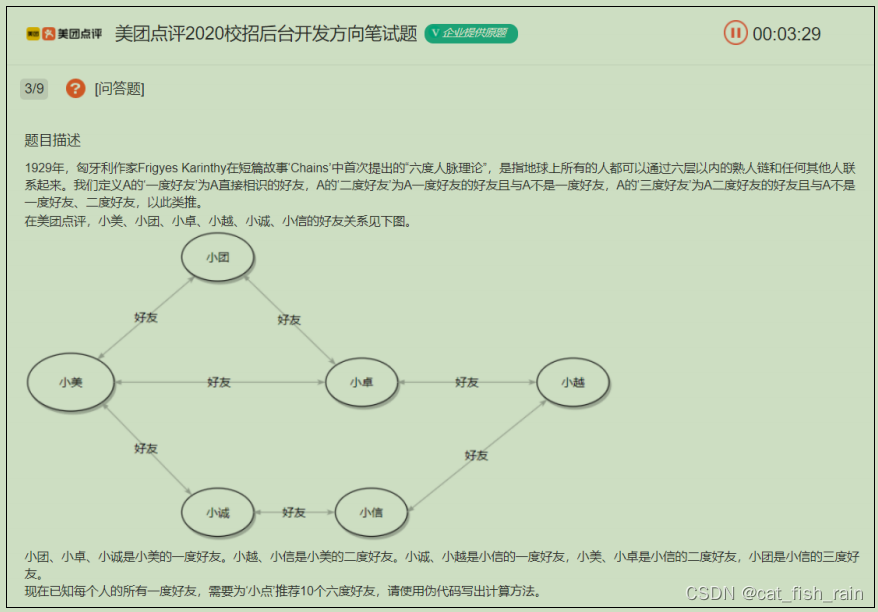
问题:如何防止节点被重复遍历
#include <iostream>
#include <vector>
#include<queue>
#include <map>
#include <algorithm>
using namespace std;
namespace LinkTable
{
template <class W>
struct LinkEgde
{
int _srcIndex;
int _dstIndex;
W _w;
LinkEgde<W> *_next;
LinkEgde(const W &w) : _srcIndex(-1), _dstIndex(-1), _w(w), _next(nullptr) {}
};
template <class V, class W, bool Direction = false>
class Graph
{
typedef LinkEgde<W> Edge;
public:
Graph(const V *vertexs, size_t n)
{
_vertexs.reserve(n);
for (size_t i = 0; i < n; i++)
{
_vertexs.push_back(_vertexs[i]);
_vIndexMap[_vertexs[i]] = i;
}
_linkTable.resize(n, nullptr);
}
size_t GetVertexIndex(const V &v)
{
auto ret = _vIndexMap.find(v);
if (ret != _vIndexMap.end())
{
return ret->second;
}
else
{
throw invalid_argument("not exist vertex");
return -1;
}
}
void AddEdge(const V &src, const V &dst, const W &w)
{
size_t srcindex = GetVertexIndex(src);
size_t dstindex = GetVertexIndex(dst);
Edge *sd_edge = new Edge(w);
sd_edge->_srcIndex = srcindex;
sd_edge->_dstIndex = dstindex;
sd_edge->_next = _linkTable[srcindex];
_linkTable[srcindex] = sd_edge;
//如果是无向图
if (Direction == false)
{
Edge *ds_edge = new Edge(w);
ds_edge->_srcIndex = dstindex;
ds_edge->_dstIndex = srcindex;
ds_edge->_next = _linkTable[dstindex];
_linkTable[dstindex] = ds_edge;
}
}
void BFS(const V & src){
size_t srcindex=GetVertexIndex(src);
vector<boo> visited;
visited.resize(_vertexs.size(),false);
queue<int> q;
q.push(srcindex);
visited[srcindex]=true;
size_t d=1;
size_t dSize=1;
while(!q.empty()){
printf("%s",src.c_str(),d);
while (d--)
{
size_t front=q.front();
q.pop();
for(size_t i=0;i<_vertexs.size();i++){
if(visited[i]!=true&&_matrix[front][i]!=MAX_W)
printf("[%d:%s]",i,_vertexs[i].c_str());
visited[i]=true;
q.push(i);
}
}
cout<<endl;
}
}
private:
map<string, int> _vIndexMap;
vector<V> _vertexs; //顶点集合
vector<Edge *> _linkTable; //边的集合
};
void TestGraph()
{
string a[] = {"zhangsan", "lisi", "wangwu", "zhaoliu"};
Graph<string, int> g1(a, 4);
g1.AddEdge("zhangsan", "lisi", 100);
g1.AddEdge("zhangsan", "wangwu", 200);
g1.AddEdge("wangwu", "zhaoliu", 30);
g1.BFS("zhangsan");
}
}
int main()
{
LinkTable::TestGraph();
system("pause");
return 0;
}1.2 图的深度优先遍历
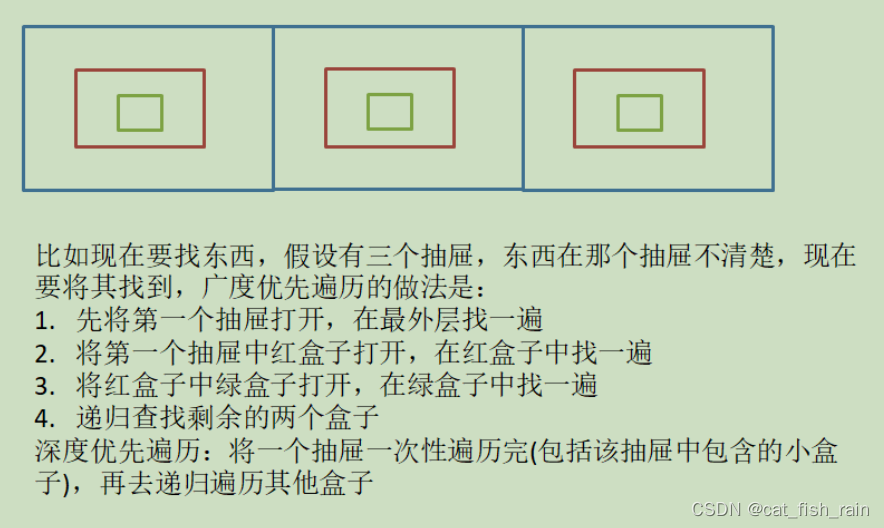

void _DFS(int index, vector<bool>& visited)
{
if(!visited[index])
{
cout<<_v[index]<<" ";
visited[index] = true;
LinkEdge* pCur = _linkEdges[index];
while(pCur)
{
_DFS(pCur->_dst, visited);
pCur = pCur->_pNext;
}
}
}
void DFS(const V& v)
{
cout<<"DFS:";
vector<bool> visited(_v.size(), false);
_DFS(GetIndexOfV(v), visited);
for(size_t index = 0; index < _v.size(); ++index)
_DFS(index, visited);
cout<<endl;
}
void TestGraphDBFS()
{
string a[] = { "张三", "李四", "王五", "赵六", "周七" };
Graph<string, int> g1(a, sizeof(a)/sizeof(string));
g1.AddEdge("张三", "李四", 100);
g1.AddEdge("张三", "王五", 200);
g1.AddEdge("王五", "赵六", 30);
g1.AddEdge("王五", "周七", 30);
g1.BFS("张三");
g1.DFS("张三");
}4. 最小生成树
连通图中的每一棵生成树,都是原图的一个极大无环子图,即:
从其中删去任何一条边,生成树
就不在连通;反之,在其中引入任何一条新边,都会形成一条回路
。
若连通图由
n
个顶点组成,则其生成树必含
n
个顶点和
n-1
条边
。因此构造最小生成树的准则有三
条:
1.
只能使用图中的边来构造最小生成树
2.
只能使用恰好
n-1
条边来连接图中的
n
个顶点
3.
选用的
n-1
条边不能构成回路
构造最小生成树的方法:
Kruskal
算法
和
Prim
算法
。这两个算法都采用了
逐步求解的贪心策略
。
贪心算法:是指在问题求解时,总是做出当前看起来最好的选择。也就是说贪心算法做出的不是
整体 最优的的选择,而是某种意义上的局部最优解。贪心算法不是对所有的问题都能得到整体最优解
4.1 Kruskal算法
任给一个有n个顶点的连通网络N={V,E},首先构造一个由这n个顶点组成、不含任何边的图G={V,NULL},其中每个顶点自成一个连通分量,其次不断从E中取出权值最小的一条边(若有多条任取其一),若该边的两个顶点来自不同的连通分量,则将此边加入到G中。如此重复,直到所有顶点在同一个连通分量上为止。核心:每次迭代时,选出一条具有最小权值,且两端点不在同一连通分量上的边,加入生成树。
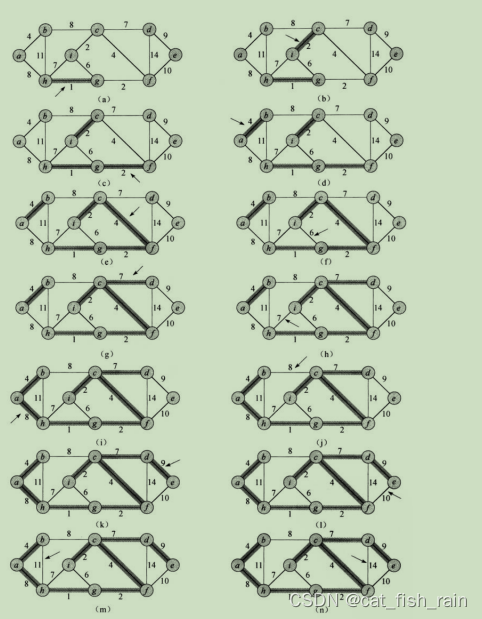
W Kruskal(Self& minTree)
{
minTree._vertexs = _vertexs;
minTree._vIndexMap = _vIndexMap;
minTree._matrix.resize(_vertexs.size());
for (auto& e : minTree._matrix)
{
e.resize(_vertexs.size(), MAX_W);
}
priority_queue<Edge, vector<Edge>, greater<Edge>> pq;
for (size_t i = 0; i < _matrix.size(); ++i)
{
for (size_t j = 0; j < _matrix[i].size(); ++j)
{
if (i < j && _matrix[i][j] != MAX_W)
{
pq.push(Edge(i, j, _matrix[i][j]));
}
}
}
W total = W();
// 贪心算法,从最小的边开始选
size_t i = 1;
UnionFindSet ufs(_vertexs.size());
while (i < _vertexs.size() && !pq.empty())
{
Edge min = pq.top();
pq.pop();
// 边不在一个集合,说明不会构成环,则添加到最小生成树
if (ufs.FindRoot(min._srci) != ufs.FindRoot(min._dsti))
{
//cout << _vertexs[min._srci] << "-" << _vertexs[min._dsti] <<
":" << _matrix[min._srci][min._dsti] << endl;
minTree._AddEdge(min._srci, min._dsti, min._w);
total += min._w;
ufs.Union(min._srci, min._dsti);
++i;
}
}
if (i == _vertexs.size())
{
return total;
}
else
{
return W();
}
}
void TestGraphMinTree()
{
const char* str = "abcdefghi";
Graph<char, int> g(str, strlen(str));
g.AddEdge('a', 'b', 4);
g.AddEdge('a', 'h', 8);
//g.AddEdge('a', 'h', 9);
g.AddEdge('b', 'c', 8);
g.AddEdge('b', 'h', 11);
g.AddEdge('c', 'i', 2);
g.AddEdge('c', 'f', 4);
g.AddEdge('c', 'd', 7);
g.AddEdge('d', 'f', 14);
g.AddEdge('d', 'e', 9);
g.AddEdge('e', 'f', 10);
g.AddEdge('f', 'g', 2);
g.AddEdge('g', 'h', 1);
g.AddEdge('g', 'i', 6);
g.AddEdge('h', 'i', 7);
Graph<char, int> kminTree;
cout << "Kruskal:" << g.Kruskal(kminTree) << endl;
kminTree.Print();
Graph<char, int> pminTree;
cout << "Prim:" << g.Prim(pminTree, 'a') << endl;
pminTree.Print();
}4.2 Prim算法
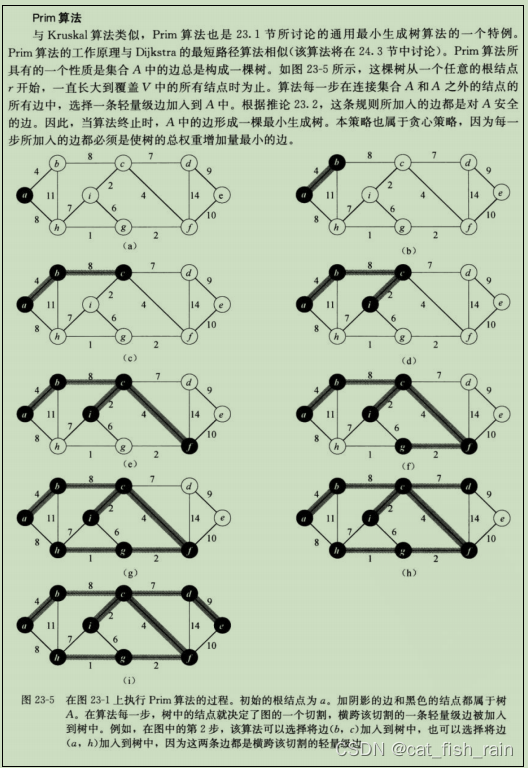
W Prim(Self& minTree, const V& src)
{
minTree._vertexs = _vertexs;
minTree._vIndexMap = _vIndexMap;
minTree._matrix.resize(_vertexs.size());
for (auto& e : minTree._matrix)
{
e.resize(_vertexs.size(), MAX_W);
}
size_t srci = GetVertexIndex(src);
set<size_t> inSet;
inSet.insert(srci);
priority_queue<Edge, vector<Edge>, greater<Edge>> pq;
for (size_t i = 0; i < _vertexs.size(); ++i)
{
if (_matrix[srci][i] != MAX_W)
{
pq.push(Edge(srci, i, _matrix[srci][i]));
}
}
W total = W();
while (inSet.size() < _vertexs.size() && !pq.empty())
{
Edge min = pq.top();
pq.pop();
// 防止环的问题
if (inSet.find(min._srci) == inSet.end() ||
inSet.find(min._dsti) == inSet.end())
{
//cout << _vertexs[min._srci] << "-" <<
_vertexs[min._dsti] << ":" << _matrix[min._srci][min._dsti] << endl;
minTree._AddEdge(min._srci, min._dsti, min._w);
total += min._w;
// 新入顶点的连接边进入队列
for (size_t i = 0; i < _vertexs.size(); ++i)
{
if (_matrix[min._dsti][i] != MAX_W && inSet.find(i)
== inSet.end())
{
pq.push(Edge(min._dsti, i, _matrix[min._dsti]
[i]));
}
}
inSet.insert(min._dsti);
}
}
if (inSet.size() == _vertexs.size())
{
return total;
}
else
{
return W();
}
}
void TestGraphMinTree()
{
const char* str = "abcdefghi";
Graph<char, int> g(str, strlen(str));
g.AddEdge('a', 'b', 4);
g.AddEdge('a', 'h', 8);
//g.AddEdge('a', 'h', 9);
g.AddEdge('b', 'c', 8);
g.AddEdge('b', 'h', 11);
g.AddEdge('c', 'i', 2);
g.AddEdge('c', 'f', 4);
g.AddEdge('c', 'd', 7);
g.AddEdge('d', 'f', 14);
g.AddEdge('d', 'e', 9);
g.AddEdge('e', 'f', 10);
g.AddEdge('f', 'g', 2);
g.AddEdge('g', 'h', 1);
g.AddEdge('g', 'i', 6);
g.AddEdge('h', 'i', 7);
Graph<char, int> kminTree;
cout << "Kruskal:" << g.Kruskal(kminTree) << endl;
kminTree.Print();
Graph<char, int> pminTree;
cout << "Prim:" << g.Prim(pminTree, 'a') << endl;
pminTree.Print();
}5. 最短路径
最短路径问题:从在带权有向图
G
中的某一顶点出发,找出一条通往另一顶点的最短路径,最短也就是沿路径各边的权值总和达到最小。
5.1单源最短路径--Dijkstra算法
单源最短路径问题:给定一个图
G = ( V
,
E ) G=(V
,
E)G=(V
,
E)
,求源结点
s
∈
V s
∈
Vs
∈
V
到图
中每个结点
v
∈
V v
∈
Vv
∈
V
的最短路径。
Dijkstra
算法就适用于解决带权重的有向图上的单源最短
路径问题,
同时算法要求图中所有边的权重非负
。一般在求解最短路径的时候都是已知一个起点
和一个终点,所以使用
Dijkstra
算法求解过后也就得到了所需起点到终点的最短路径。
针对一个带权有向图
G
,将所有结点分为两组
S
和
Q
,
S
是已经确定最短路径的结点集合,在初始时
为空(初始时就可以将源节点
s
放入,毕竟源节点到自己的代价是
0
),
Q
为其余未确定最短路径
的结点集合,
每次从
Q
中找出一个起点到该结点代价最小的结点
u
,将
u
从
Q
中移出,并放入
S
中,对
u
的每一个相邻结点
v
进行松弛操作
。松弛即对每一个相邻结点
v
,判断源节点
s
到结点
u
的代价与
u
到
v
的代价之和是否比原来
s
到
v
的代价更小,若代价比原来小则要将
s
到
v
的代价更新
为
s
到
u
与
u
到
v
的代价之和,否则维持原样。如此一直循环直至集合
Q
为空,即所有节点都已经
查找过一遍并确定了最短路径,至于一些起点到达不了的结点在算法循环后其代价仍为初始设定
的值,不发生变化。
Dijkstra
算法每次都是选择
V-S
中最小的路径节点来进行更新,并加入
S
中,所
以该算法使用的是贪心策略。
Dijkstra
算法存在的问题是不支持图中带负权路径,如果带有负权路径,则可能会找不到一些路
径的最短路径。
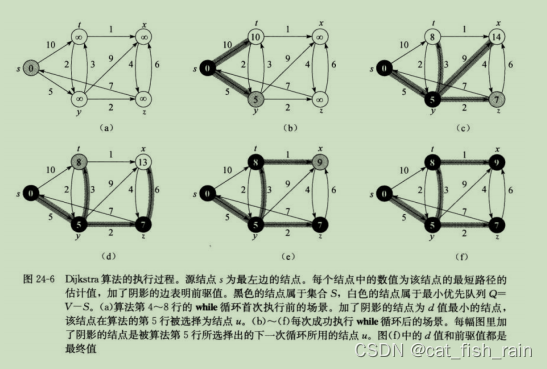
void Dijkstra(const V& src, vector<W>& dist, vector<int>& parentPath)
{
size_t N = _vertexs.size();
size_t srci = GetVertexIndex(src);
// vector<W> dist,记录srci-其他顶点最短路径权值数组
dist.resize(N, MAX_W);
// vector<int> parentPath 记录srci-其他顶点最短路径父顶点数组
parentPath.resize(N, -1);
// 标记是否找到最短路径的顶点集合S
vector<bool> S;
S.resize(N, false);
// srci的权值给一个最小值,方便贪心第一次找到这个节点
dist[srci] = W();
// N个顶点更新N次
for (size_t i = 0; i < N; ++i)
{
// 贪心算法:srci到不在S中路径最短的那个顶点u
W min = MAX_W;
size_t u = srci;
for (size_t j = 0; j < N; ++j)
{
if (S[j] == false && dist[j] < min)
{
min = dist[j];
u = j;
}
}
S[u] = true;
// 松弛算法:更新一遍u连接的所有边,看是否能更新出更短连接路径
for (size_t k = 0; k < N; ++k)
{
// 如果srci->u + u->k 比 srci->k更短 则进行更新
if (S[k] == false && _matrix[u][k] != MAX_W
&& dist[u] + _matrix[u][k] < dist[k])
{
dist[k] = dist[u] + _matrix[u][k];
parentPath[k] = u;
}
}
}
}
// 打印最短路径的逻辑算法
void PrinrtShotPath(const V& src, const vector<W>& dist, const vector<int>&
parentPath)
{
size_t N = _vertexs.size();
size_t srci = GetVertexIndex(src);
for (size_t i = 0; i < N; ++i)
{
if (i == srci)
continue;
vector<int> path;
int parenti = i;
while (parenti != srci)
{
path.push_back(parenti);
parenti = parentPath[parenti];
}
path.push_back(srci);
reverse(path.begin(), path.end());
for (auto pos : path)
{
cout << _vertexs[pos] << "->";
}
cout << dist[i] << endl;
}
}
void TestGraphDijkstra()
{
const char* str = "syztx";
Graph<char, int, INT_MAX, true> g(str, strlen(str));
g.AddEdge('s', 't', 10);
g.AddEdge('s', 'y', 5);
g.AddEdge('y', 't', 3);
g.AddEdge('y', 'x', 9);
g.AddEdge('y', 'z', 2);
g.AddEdge('z', 's', 7);
g.AddEdge('z', 'x', 6);
g.AddEdge('t', 'y', 2);
g.AddEdge('t', 'x', 1);
g.AddEdge('x', 'z', 4);
vector<int> dist;
vector<int> parentPath;
g.Dijkstra('s', dist, parentPath);
g.PrinrtShotPath('s', dist, parentPath);
// 图中带有负权路径时,贪心策略则失效了。
// 测试结果可以看到s->t->y之间的最短路径没更新出来
/*const char* str = "sytx";
Graph<char, int, INT_MAX, true> g(str, strlen(str));
g.AddEdge('s', 't', 10);
g.AddEdge('s', 'y', 5);
g.AddEdge('t', 'y', -7);
g.AddEdge('y', 'x', 3);
vector<int> dist;
vector<int> parentPath;
g.Dijkstra('s', dist, parentPath);
g.PrinrtShotPath('s', dist, parentPath);*/
}5.2 单源最短路径--Bellman-Ford算法
Dijkstra
算法只能用来解决正权图的单源最短路径问题,但有些题目会出现负权图。这时这个算法
就不能帮助我们解决问题了,而
bellman—ford
算法可以解决负权图的单源最短路径问题
。它的
优点是可以解决有负权边的单源最短路径问题,而且可以用来判断是否有负权回路。它也有明显
的缺点,它的时间复杂度
O(N*E) (N
是点数,
E
是边数
)
普遍是要高于
Dijkstra
算法
O(N²)
的。像这里
如果我们使用邻接矩阵实现,那么遍历所有边的数量的时间复杂度就是
O(N^3)
,这里也可以看出
来
Bellman-Ford
就是一种暴力求解更新。
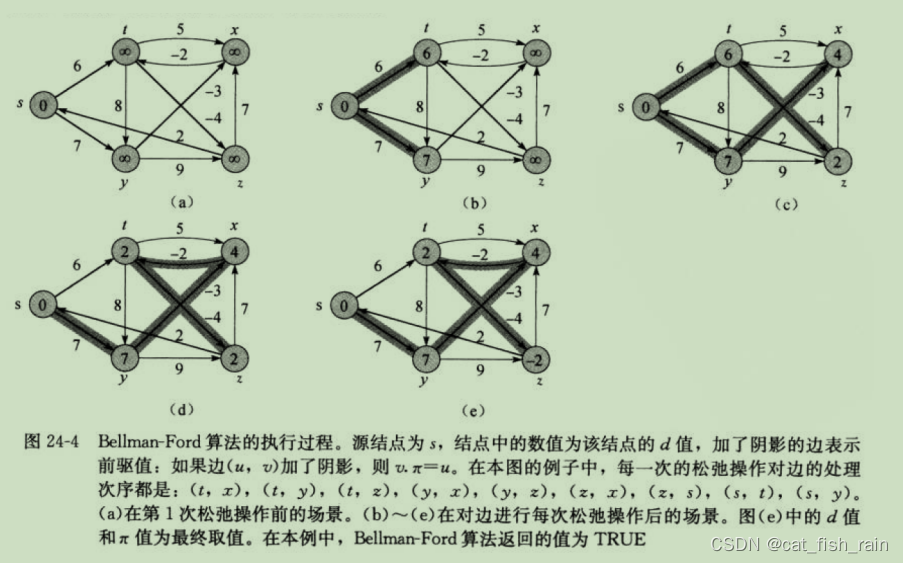
bool BellmanFord(const V& src, vector<W>& dist, vector<int>& parentPath)
{
size_t N = _vertexs.size();
size_t srci = GetVertexIndex(src);
// vector<W> dist,记录srci-其他顶点最短路径权值数组
dist.resize(N, MAX_W);
// vector<int> parentPath 记录srci-其他顶点最短路径父顶点数组
parentPath.resize(N, -1);
// 先更新srci->srci为最小值
dist[srci] = W();
for (size_t k = 0; k < N - 1; ++k)
{
bool exchange = false;
for (size_t i = 0; i < N; ++i)
{
for (size_t j = 0; j < N; ++j)
{
// srci->i + i->j < srci->j 则更新路径及权值
if (_matrix[i][j] != MAX_W
&& dist[i] + _matrix[i][j] < dist[j])
{
dist[j] = dist[i] + _matrix[i][j];
parentPath[j] = i;
exchange = true;
}
}
}
if (exchange == false)
break;
}
for (size_t i = 0; i < N; ++i)
{
for (size_t j = 0; j < N; ++j)
{
// 检查有没有负权回路
if (_matrix[i][j] != MAX_W
&& dist[i] + _matrix[i][j] < dist[j])
{
return false;
}
}
}
return true;
}
void TestGraphBellmanFord()
{
const char* str = "syztx";
Graph<char, int, INT_MAX, true> g(str, strlen(str));
g.AddEdge('s', 't', 6);
g.AddEdge('s', 'y', 7);
g.AddEdge('y', 'z', 9);
g.AddEdge('y', 'x', -3);
g.AddEdge('z', 's', 2);
g.AddEdge('z', 'x', 7);
g.AddEdge('t', 'x', 5);
g.AddEdge('t', 'y', 8);
g.AddEdge('t', 'z', -4);
g.AddEdge('x', 't', -2);
vector<int> dist;
vector<int> parentPath;
if (g.BellmanFord('s', dist, parentPath))
{
g.PrinrtShotPath('s', dist, parentPath);
}
else
{
cout << "存在负权回路" << endl;
}
// 微调图结构,带有负权回路的测试
//const char* str = "syztx";
//Graph<char, int, INT_MAX, true> g(str, strlen(str));
//g.AddEdge('s', 't', 6);
//g.AddEdge('s', 'y', 7);
//g.AddEdge('y', 'x', -3);
//g.AddEdge('y', 'z', 9);
//g.AddEdge('y', 'x', -3);
//g.AddEdge('y', 's', 1); // 新增
//g.AddEdge('z', 's', 2);
//g.AddEdge('z', 'x', 7);
//g.AddEdge('t', 'x', 5);
//g.AddEdge('t', 'y', -8); // 更改
//g.AddEdge('t', 'z', -4);
//g.AddEdge('x', 't', -2);
//vector<int> dist;
//vector<int> parentPath;
//if (g.BellmanFord('s', dist, parentPath))
//{
// g.PrinrtShotPath('s', dist, parentPath);
//}
//else
//{
// cout << "存在负权回路" << endl;
//}
}5.3 多源最短路径--Floyd-Warshall算法
Floyd-Warshall
算法是解决任意两点间的最短路径的一种算法。Floyd算法考虑的是一条最短路径的中间节点,即简单路径
p={v1,v2,…,vn}
上除
v1
和
vn
的任意节点。
设
k
是
p
的一个中间节点,那么从
i
到
j
的最短路径
p
就被分成
i
到
k
和
k
到
j
的两段最短路径
p1
,
p2
。
p1
是从
i
到
k
且中间节点属于
{1
,
2
,
…
,
k-1}
取得的一条最短路径。
p2
是从
k
到
j
且中间节点属于
{1
,
2
,
…
,
k-1}
取得的一条最短路径。


即
Floyd
算法本质是三维动态规划,
D[i][j][k]
表示从点
i
到点
j
只经过
0
到
k
个点最短路径,然后建立
起转移方程,然后通过空间优化,优化掉最后一维度,变成一个最短路径的迭代算法,最后即得
到所以点的最短路。
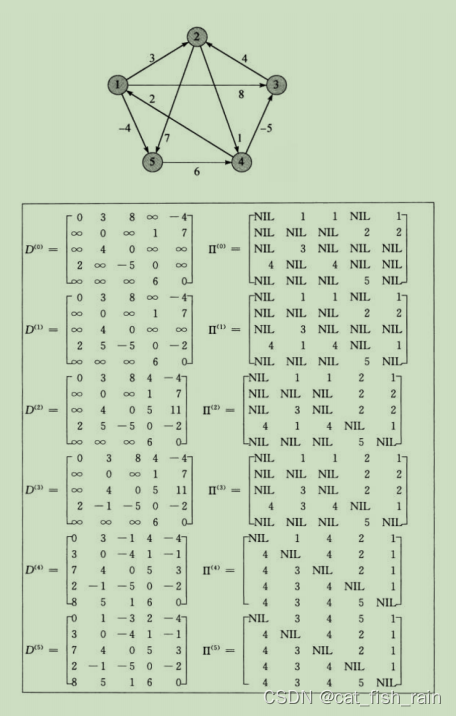
void FloydWarShall(vector<vector<W>>& vvDist, vector<vector<int>>&
vvParentPath)
{
size_t N = _vertexs.size();
vvDist.resize(N);
vvParentPath.resize(N);
// 初始化权值和路径矩阵
for (size_t i = 0; i < N; ++i)
{
vvDist[i].resize(N, MAX_W);
vvParentPath[i].resize(N, -1);
}
// 将直接相连的路径初始化
for (size_t i = 0; i < N; ++i)
{
for (size_t j = 0; j < N; ++j)
{
if (_matrix[i][j] != MAX_W)
{
vvDist[i][j] = _matrix[i][j];
vvParentPath[i][j] = i;
}
else
{
vvParentPath[i][j] = -1;
}
if (i == j)
{
vvDist[i][j] = 0;
vvParentPath[i][j] = -1;
}
}
}
// 依次用顶点k作为中转点更新最短路径
for (size_t k = 0; k < N; ++k)
{
for (size_t i = 0; i < N; ++i)
{
for (size_t j = 0; j < N; ++j)
{
// i->k + k->j 比 i->j前面更新的距离更短,则更新
if (vvDist[i][k] != MAX_W && vvDist[k][j] != MAX_W
&& vvDist[i][k] + vvDist[k][j] < vvDist[i][j])
{
vvDist[i][j] = vvDist[i][k] + vvDist[k][j];
vvParentPath[i][j] = vvParentPath[k][j];
}
}
}
// 打印权值和路径矩阵观察数据
//for (size_t i = 0; i < N; ++i)
//{
// for (size_t j = 0; j < N; ++j)
// {
// if (vvDist[i][j] == MAX_W)
// {
// //cout << "*" << " ";
// printf("%3c", '*');
// }
// else
// {
// //cout << vvDist[i][j] << " ";
// printf("%3d", vvDist[i][j]);
// }
// }
// cout << endl;
//}
//cout << endl;
//for (size_t i = 0; i < N; ++i)
//{
// for (size_t j = 0; j < N; ++j)
// {
// //cout << vvParentPath[i][j] << " ";
// printf("%3d", vvParentPath[i][j]);
// }
// cout << endl;
//}
//cout << "=================================" << endl;
}
}
void TestFloydWarShall()
{
const char* str = "12345";
Graph<char, int, INT_MAX, true> g(str, strlen(str));
g.AddEdge('1', '2', 3);
g.AddEdge('1', '3', 8);
g.AddEdge('1', '5', -4);
g.AddEdge('2', '4', 1);
g.AddEdge('2', '5', 7);
g.AddEdge('3', '2', 4);
g.AddEdge('4', '1', 2);
g.AddEdge('4', '3', -5);
g.AddEdge('5', '4', 6);
vector<vector<int>> vvDist;
vector<vector<int>> vvParentPath;
g.FloydWarShall(vvDist, vvParentPath);
// 打印任意两点之间的最短路径
for (size_t i = 0; i < strlen(str); ++i)
{
g.PrinrtShotPath(str[i], vvDist[i], vvParentPath[i]);
cout << endl;
}
}


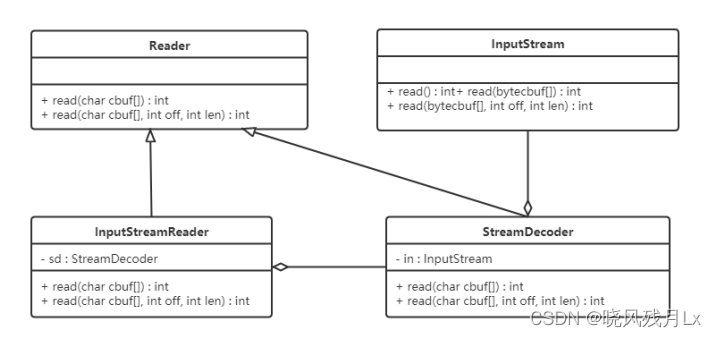

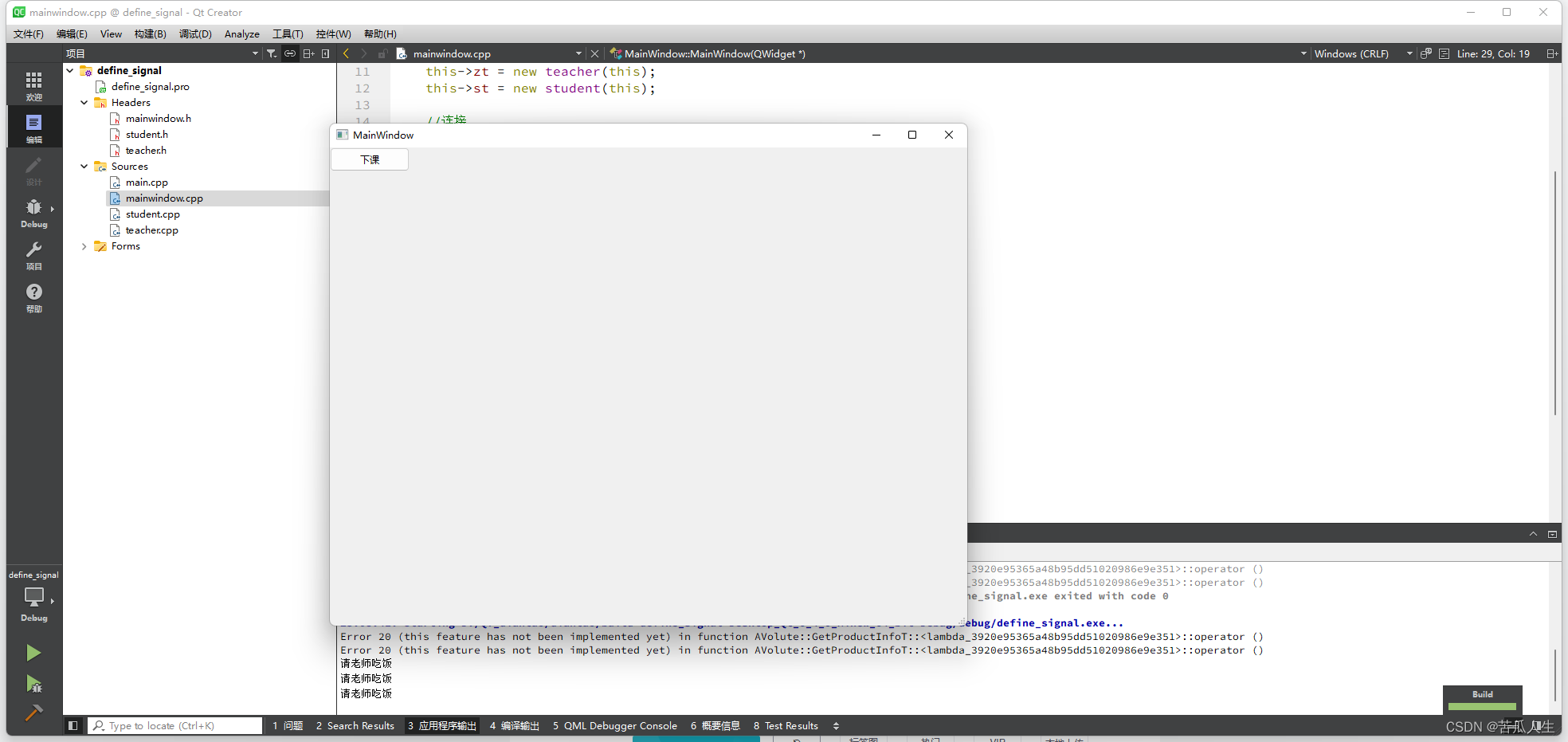



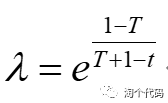



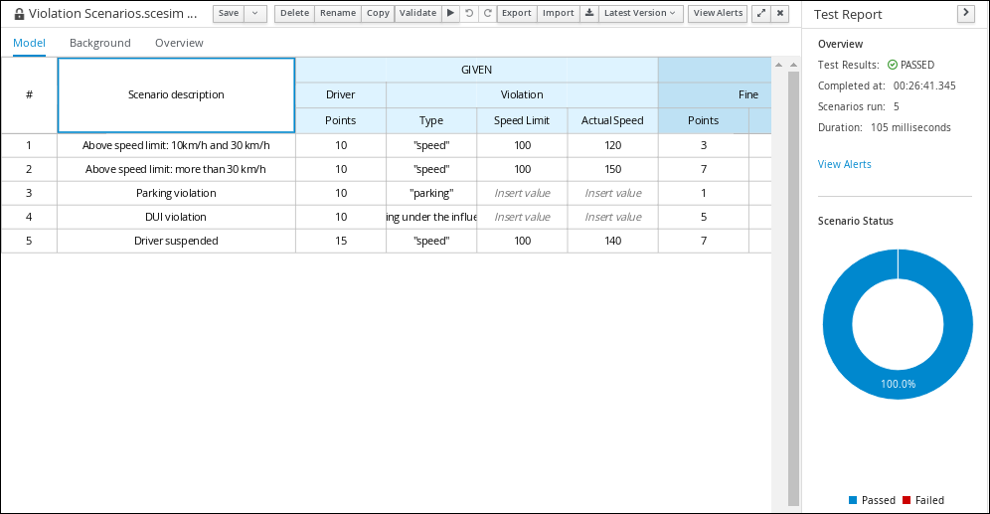
![[探地雷达]利用Faster RCNN对B-SCAN探地雷达数据进行目标检测](https://img-blog.csdnimg.cn/491979c290f04b53b67f55132951093d.png)



